
The Leopard 2 is a main battle tank developed by Krauss-Maffei in the 1970s for the West German Army. The tank first entered service in 1979 and succeeded the earlier Leopard 1 as the main battle tank of the German Army. It is armed with a 120 mm smoothbore cannon, and is powered by a V-12 twin-turbo diesel engine. Various versions have served in the armed forces of Germany and 12 other European countries, as well as several non-European nations, including Canada, Chile, Indonesia, Singapore, and Turkey. The Leopard 2 was used in Kosovo with the German Army, and has seen action in Afghanistan with the Dutch, Danish and Canadian contributions to the International Security Assistance Force, as well as seeing action in Syria with the Turkish Armed Forces.
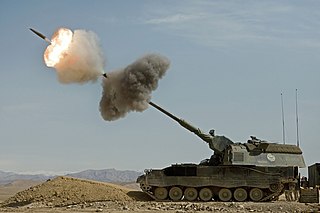
The Panzerhaubitze 2000, abbreviated PzH 2000, is a German 155 mm self-propelled howitzer developed by Krauss-Maffei Wegmann (KMW) and Rheinmetall for the German Army. The PzH 2000 is one of the most powerful conventional artillery systems deployed in the 2010s. It is capable of a very high rate of fire; in burst mode it can fire three rounds in nine seconds, ten rounds in 56 seconds, and can—depending on barrel heating—fire between 10 and 13 rounds per minute continuously. The PzH 2000 has automatic support for up to 5 rounds of Multiple Rounds Simultaneous Impact (MRSI). The replenishment of shells is automated. Two operators can load 60 shells and propelling charges in less than 12 minutes. PzH 2000 has also been selected by the armies of Italy, Netherlands, Greece, Lithuania, Hungary, Qatar and Croatia, mostly replacing older systems like the M109 howitzers.

Maffei was a manufacturer of railway locomotives based in Munich, Germany. Established in 1836, it prospered for nearly a century before going bankrupt in 1930 and becoming amalgamated with the firm of Krauss to form Krauss-Maffei. Following another seventy years of prosperity Krauss-Maffei merged with Demag and Mannesmann in 1999, the resulting conglomerate in turn being sold to Siemens AG.

Under the Whyte notation for the classification of steam locomotives, 4-4-4 represents the wheel arrangement of four leading wheels on two axles, four powered and coupled driving wheels on two axles, and four trailing wheels on two axles. In the United States, this arrangement was named the Reading type, since the Philadelphia and Reading Railroad was the first to use it. In Canada, this type is known as the Jubilee.
Maschinenbau Kiel GmbH designed, manufactured and marketed marine diesel engines, diesel locomotives and tracked vehicles under the MaK brand name. The three primary operating divisions of Maschinenbau Kiel GmbH were sold to different companies in the 1990s.

Hellenic Vehicle Industry (ELVO) is a Greek vehicle manufacturer based in Thessaloniki.

The Fennek, named after the fennec, or LGS Fennek, with LGS being short for Leichter Gepanzerter Spähwagen in German, is a four-wheeled armed reconnaissance vehicle produced by the German company Krauss-Maffei Wegmann and Dutch Defence Vehicle Systems. The Turkish company FNSS Defence Systems acquired the right for licence production in 2004. It was developed for both the German Army and Royal Netherlands Army to replace their current vehicles.

Demag Cranes AG is a German heavy equipment manufacturer now controlled by Finland-based Konecranes. The roots of Demag date back prior to its formation, but became Märkische Maschinenbau-Anstalt, Ludwig A.-G in 1906 as the biggest crane building company in Germany employing 250-300 people. The company was a manufacturer of industrial cranes that included types like, bridge cranes, hoist (device), overhead cranes, Gantry crane to name a few. In 1910 came the hour of the Deutsche Maschinenfabrik in Duisburg – known worldwide by its telegram abbreviation Demag. In 1973 The Mannesmann group assumed ownership of Demag. Since that time the company has continued to grow and change. Parts of the company under core business structuring moved from its ownership to focus the main concept of the company.

The ATF Dingo is a German heavily armored military MRAP infantry mobility vehicle based on a Unimog chassis with a V-hull design, produced by the company Krauss-Maffei Wegmann (KMW). It is designed to withstand land mines, rifle fire, artillery fragments and NBC-threats. ATF stands for Allschutz-Transport-Fahrzeug, meaning all-protected transport vehicle in German. It is named after the Australian native dog, the dingo. Currently KMW is developing the Dingo 2 GFF for the German Army with increased internal volume.
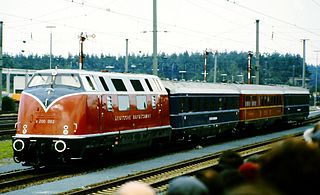
DB Class V 200 was the first series production diesel-hydraulic express locomotive of the German Deutsche Bundesbahn and - as Am 4/4 - of the SBB-CFF-FFS in Switzerland.

Krauss-Maffei Wegmann GmbH & Co. KG (KMW) is a defence company based in Munich, Germany. The company produces various types of equipment as well as railroad locomotives, tanks, self-propelled artillery, and other armoured vehicles.

The Leopardo 2E or Leopard 2A6E is a variant of the German Leopard 2 main battle tank, tailored to the requirements of the Spanish army, which acquired it as part of an armament modernization program named Programa Coraza, or Program Cuirass. The acquisition program for the Leopard 2E began in 1994, five years after the cancellation of the Lince tank program that culminated in an agreement to transfer 108 Leopard 2A4s to the Spanish army in 1998 and started the local production of the Leopard 2E in December 2003. Despite postponement of production owing to the 2003 merger between Santa Bárbara Sistemas and General Dynamics, and continued fabrication issues between 2006 and 2007, 219 Leopard 2Es have been delivered to the Spanish army.

The Class S 3/6 steam locomotives of the Royal Bavarian State Railways were express train locomotives with a 4-6-2 Pacific or 2'C1' wheel arrangement.

The Krauss-Maffei ML 4000 is a road switcher diesel-hydraulic locomotive, built between 1961 and 1969 by German manufacturer Krauss-Maffei in Munich, Germany. It generated 3,540 horsepower (2,640 kW) from two Maybach V16 engines. 37 examples were built for two North American railroads and one South American railroad.
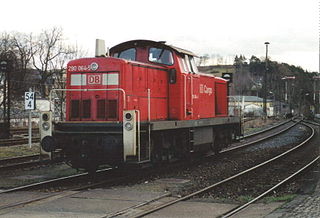
The DB Class V90 locomotive is a German road switcher diesel-hydraulic locomotive for shunting and freight hauling.
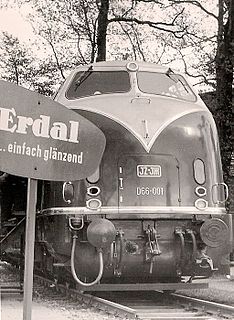
The diesel-hydraulic locomotive ML 2200 C'C' was a 6 axle variant of the DB Class V 200 series of locomotives, which were built for Yugoslav State Railways (JDŽ) by manufacturer Krauss-Maffei.

The Artillery Gun Module is an air-portable self-propelled howitzer designed by Krauss-Maffei Wegmann. It is based on technology used in the German Army Panzerhaubitze 2000 system, to provide more air portable self-propelled artillery, transportable by Airbus A400 aircraft.

MUltifunctional Self protection System is a soft kill active protection system developed to protect military vehicles against guided anti-tank missiles.
The KMW+Nexter Defense Systems (KNDS) is a European defence industry holding company, which is result for merger between Krauss-Maffei Wegmann and Nexter Systems.
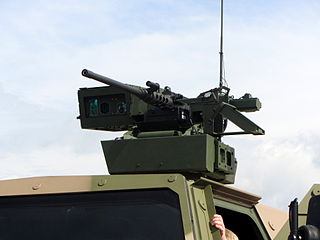
Under the name fernbedienbare leichte Waffenstation the German defence company Krauss-Maffei Wegmann brands its family of remote weapon stations. Fernbedienbare leichte Waffenstation stands for "remotely operated, light weapon station".


















